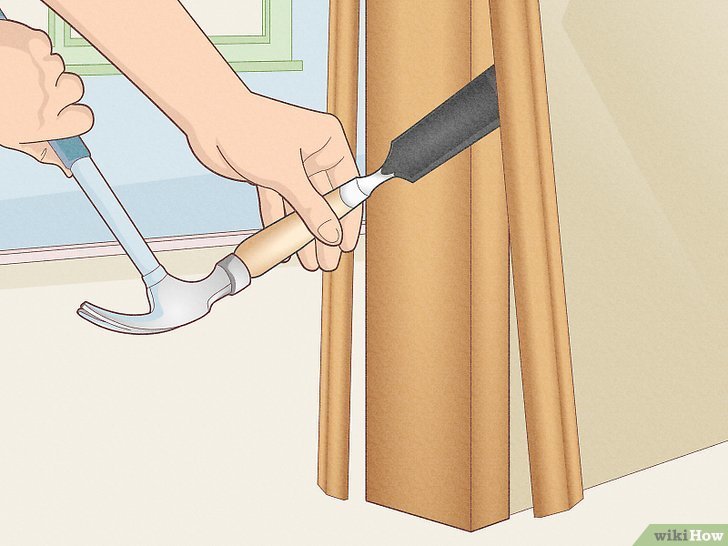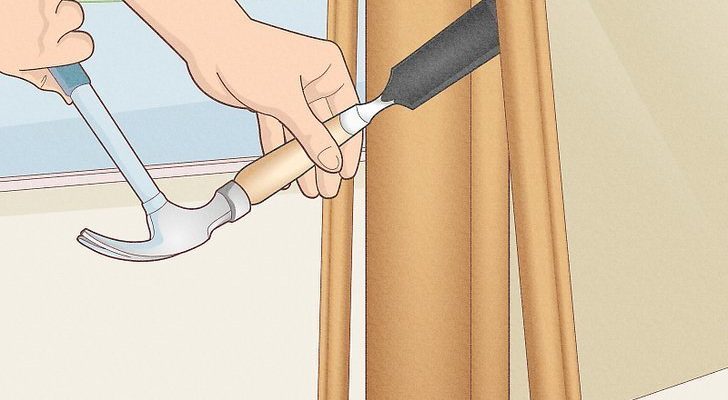
A bent door frame is sneaky because it causes all sorts of little issues: misaligned locks, stiff hinges, and even drafts you can’t get rid of. It doesn’t matter whether you’re working with a newer, pre-hung interior door from a brand like JELD-WEN, or wrestling with an old, solid-wood exterior frame from an older house. The approach is pretty much the same. You want all your door hardware—locks, latches, and even those swinging hinges—to line up as smoothly as a zipper on a new jacket. Let’s break down how you can tackle a bent door frame and get everything back in sync.
How to Spot a Bent Door Frame
First things first: if your door hardware isn’t working right, a bent frame is often to blame. But before grabbing any tools, you’ll want to confirm the problem. Most people notice the symptoms first—like when the latch won’t catch, or the deadbolt barely slides into place. But sometimes the issues are a bit sneakier: maybe the top of the door rubs against the frame, or there’s a tiny gap down one side where a draft sneaks through.
Here’s the thing: a bent door frame often leads to *hardware alignment* problems. If the door looks crooked, or if you feel resistance when opening or closing, take a closer look at the frame. Stand back and check for spots where the gap between the door and the frame isn’t even. Sometimes you’ll see the frame bowing outward or inward, especially near the hinges or near the latch.
To really nail down the issue, use a straightedge (like a long ruler or even a level) against the frame. Move it slowly along the edge—if you see daylight peeking through, or if the straightedge rocks, there’s a bend. Don’t forget to check all sides: the hinge side, latch side, and even the top. If you notice any misalignment or warping, you’ve found your culprit.
What Causes a Door Frame to Bend?
You might be wondering how a heavy, solid thing like a door frame gets bent in the first place. Honestly, it doesn’t take as much force as you’d think. Sometimes it’s a gradual thing: maybe the house has settled over time, or humidity has caused the wood to swell and shrink. Other times, it’s more sudden—a slammed door, a forced entry, or a moving mishap can all do the trick.
Here are common culprits behind a bent door frame:
- Settling foundations: As a house ages, the ground underneath can shift. That push-pull movement transfers right up to the door frames, making them bow or twist.
- Moisture problems: If you live in a humid area, wood absorbs water and can swell, then shrink back when things dry out. Over time, this cycle can warp the frame.
- Accidents or impacts: Moving furniture, slamming doors, or a good old fashioned football tackle indoors can all bend or dent frames.
- Improper installation: Sometimes the frame wasn’t perfectly square to begin with, and small errors add up over time.
No matter the cause, the end result is the same: the door hardware—your locks, latches, and hinges—ends up out of alignment. Fixing the bend is the only way to truly reset and sync everything.
Tools and Supplies You’ll Need
Let me explain—it’s tempting to just grab a hammer and start banging away, but repairing a bent door frame takes a bit of finesse. You’ll want to gather the right tools before you begin to avoid making things worse.
Most repairs call for:
- Hammer and block of wood (for gentle persuasion)
- Pry bar or flathead screwdriver (to slowly ease the frame back into position)
- Drill and wood screws (to reinforce and sync the frame)
- Wood shims (to correct gaps and stabilize the frame)
- Level or straightedge (to check your progress)
- Safety glasses and gloves (if you’ll be doing any forceful work)
If the damage is severe, you might need a replacement section of trim or even a bit of wood filler for finishing touches. For metal frames, a rubber mallet and maybe even a small adjustable wrench come in handy. You definitely don’t need to be a pro, but having the right gear makes the job a lot less stressful.
Step-By-Step: Repairing a Bent Door Frame
Ready to get hands-on? Here’s a step-by-step process to bring your frame back into line and correct that hardware alignment:
- Remove the Door: Unscrew the hinges and carefully lift the door off its frame. This makes the whole repair process safer and way easier to manage.
- Inspect for Damage: Once the door’s out of the way, look closely at the frame. Use your straightedge to pinpoint exactly where the bend is, and press gently to see if the frame moves under light pressure.
- Loosen Fasteners: Use your drill or screwdriver to loosen (but not fully remove) the screws holding the frame. This gives the frame enough play to shift back into position as you work.
- Realign the Frame: This is where a block of wood and hammer come in. Place the block against the bent part and tap gently. For tougher bends, use a pry bar or flathead screwdriver for leverage. Work slowly—check your progress often with a level or straightedge.
- Add Shims: Once the frame looks straight, push thin wooden shims behind the frame anywhere there’s a gap, especially at the hinges or latch side. These hold everything in sync while you tighten the screws again.
- Tighten and Reinforce: Drive the screws back in tightly. If the original holes are stripped, move slightly and add new screws for a firmer hold.
- Reinstall the Door: Set the door back in the frame and attach the hinges. Open and close the door several times to check for any new sticking or catching. Adjust as needed.
Tip: If the latch or deadbolt still isn’t lining up after all this, you may need to adjust the strike plate on the frame. Sometimes, just moving the hardware a few millimeters can make things click into place.
Correcting Hardware Alignment After the Frame Repair
You might be thinking, “I fixed the frame—why is the lock still sticking?” Here’s the thing: once a frame’s been bent for a while, the hardware sometimes gets out of “sync” all on its own. The holes drilled for the latch and deadbolt may be just a touch off, or the hinges might have sagged.
Start by checking each piece of hardware:
- Hinges: Open and close the door slowly. If you hear creaks or see the door sagging, tighten the screws or consider adding slightly longer screws for a firmer hold.
- Latches and Locks: Try operating each one with the door open and again with it closed. If they catch with the door open, the hardware itself needs adjustment. If only with the door closed, it’s the alignment.
- Strike Plate: Sometimes, adjusting the strike plate position is all you need to get the latch or deadbolt to “sync” up.
If needed, mark where the latch or bolt actually hits the frame. Use a chisel or small file to widen the opening, or shift the strike plate slightly. The goal is to have everything closing smoothly—no extra force, no jiggling.
When You Should Call a Pro
Let me be honest—most small bends are a perfectly doable DIY job. But there are times when calling a pro is the smarter choice. For example, if your frame is metal and seriously crumpled (like after a break-in), or if working on the frame could mess with your home’s security or code compliance, it’s best to consult an expert.
You’ll also want a pro if:
- You find signs of water damage, rot, or termites inside the frame.
- The frame won’t budge after several repair attempts.
- The door is a main point of entry and needs to be fully secure for insurance reasons.
A skilled carpenter or handyperson can usually straighten a seriously warped frame and get your hardware in sync, often in less than a day.
Preventing Future Problems
Fixing a bent door frame is great, but keeping the problem from coming back is even better. Here are a few things you can do to protect your handiwork:
- Keep an eye on moisture: If your door frame is near a bathroom or exposed to the elements, seal it well. Make sure caulking and weatherstripping are in good shape.
- Don’t slam the door: It sounds obvious, but gentle use can make a big difference over years.
- Check hardware regularly: Every few months, tighten up hinge screws and check that locks still line up smoothly.
- Watch for signs of shifting: Cracks in walls or suddenly sticking doors can all point to larger foundation issues—spot them early, and you’ll save yourself bigger headaches later.
Repairing Vs. Replacing a Door Frame
Sometimes, after looking at the problem, you might wonder if it’s even worth fixing. Here’s how I’d break it down:
- Repair: If the frame is mostly intact, the bend is mild to moderate, and the wood isn’t rotting, a repair is usually faster and cheaper. You keep your original hardware and don’t have to mess with trim or paint matching.
- Replace: If the frame is split, heavily damaged, or the whole thing is warped out of square, replacement is the better long-term fix. This makes sense for metal frames after forced entry, or for older wood frames with lots of water damage.
- Alternatives: For interior doors that aren’t heavily used or don’t need to be totally secure, sometimes you can get away with just adjusting the hardware, or even installing a universal strike plate or latch for a quick sync-up.
Think about the time, cost, and how “perfect” the final alignment needs to be. There’s no shame in patching things up if that solves your problem.
Wrapping Up: Bringing Your Door Back Into Sync
Correcting a bent door frame to fix hardware alignment can feel a little daunting, but with a careful approach and the right tools, it’s usually a straightforward fix. Don’t rush: take your time matching everything up, and double-check your work with the door open and closed. If the hardware still won’t sync up, don’t be afraid to tweak the strike plate or hinges—that’s often where the last bit of misalignment hides.
Honestly, there’s a certain satisfaction in seeing a door close smoothly after days (or weeks) of struggling. And when all the hardware finally lines up and clicks just right, you’ll know you’ve brought everything back into perfect sync—no magic code, no reset, just good old troubleshooting and hands-on repair.
